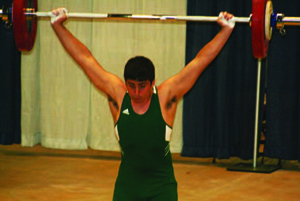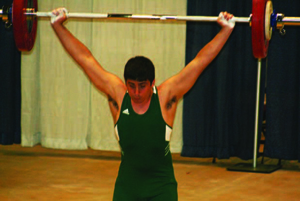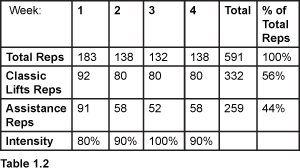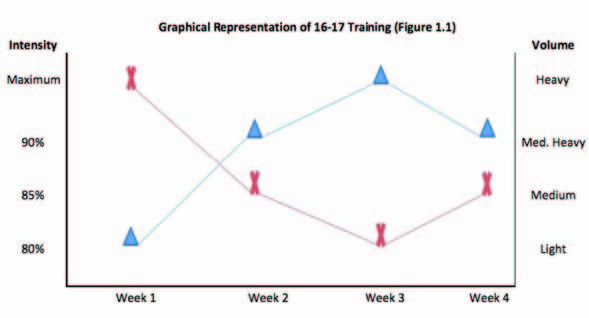16-17 Year-Old Weightlifting Program

This month the training hits a high note with the 16-17 year old training. Before I start I want to clarify something that may not have been adequately explained before; all of my lifters participate in at least one other sport, we do not have much full-time training time where their attention is not split with another sport. We have about 16 weeks before the School Age Nationals and then we have about 4 weeks after that, which is only 20 weeks out of 52. Those who play football train one day a week in season on Sunday with snatch and clean and jerk. Then in wrestling season they train twice a week with snatch and squat on one day and clean and jerk and pull on the other.

So when their other sports are done we have to train very hard and heavy constantly in order to be in good shape for the School Age Nationals. However, these programs do work well in a nearly year round setting; the only change would be to reduce the workload by going back to say the 13&U for a month or two then to the 14-15 for a month or two and back to this workout (see Table 1.1 for example). The Beginner and 13&U programs could be done year round and as the lifters grow up we sometime revert back to the 13&U to help smooth out technique issues or to give a break for a month or two to let the lifter relax during the off-season. However, for most U.S. coaches, full-time lifters at this age are rarities, as is the case with my guys, so we do not go back in the programs very often, as we only have time for Blitzkrieg training in which the Bulgarian methods work best.
.jpg)
There have been some major changes to this workout in relation the previous two. The first change is that this time the intensity of training has been increased rather than the volume. Before with each new workout the volume of work was increased and the intensity held constant; now the volume has actually been reduced (from 754 total reps to 591 total reps). The intensity has been increased; the 85% week has been replaced with a second week of 90% training. Again, this balancing act between volume and intensity is crucial in order to ease the transition between programs and allow adaptation to occur. The result should be an increased “explosion” in the lifts between programs rather than the start of diminishing returns.
Looking at table 1.2, it can be seen that 56% of the total reps are in the classic lifts and only 44% are in the assistance exercises. Also, note that each week the number of reps in the classic lifts outnumbers the reps in the assistance lifts. The idea is to increase the quality of contest preparation with max and sub-max weights, which cannot be achieved by doing pseudo-lifts. The power versions and pulls are only done on Wednesday as a way to keep the intensity up while giving their bodies a little rest and the snatch and clean pulls are rotated weekly; squats are done four days a week after the lifts.

A special note should be made in regards to the 80% week. The 80% week up until this point has been used as a teaching week, hence the higher reps to encourage perfection and consistency of technique. Starting with the 16-17 program and onward, the 80% week has a new role—lower intensity, higher repetitions—resting the nervous system while still working the muscles. In the 13&U the 80% week consisted of 80% weights lifted for 2 sets of 3 reps. Then in the 14-15 program 80% weights were lifted for 3 sets of 2 reps. In the 16-17 program 80% is lifted for a double in the snatch followed by 3 singles and it is lifted for 5 singles in the clean and jerk. When training in this type of high intensity manner it is beneficial to have a built-in “down” week so that progress does not give way to fatigue—you must be on the lookout for the proverbial wall.

Looking at the graphical representation of the 16-17 training program, you can see the widening gap (read that as importance) of the intensity-volume relationship. The wider the gap between the two indicator lines represents the increasing importance of one factor (in our case intensity) and the decreasing importance of the second factor (volume).
Looking at the workout itself it can easily be seen from a quick glance that this workout places a higher demand on the nervous system. In previous workouts, 90% would only be lifted three times a week in the classic lifts; now it must be lifted four times in the same week. There are fewer active rest days (powers and pulls)—reducing the powers and pulls helps to lower all unnecessary loading and allow for increased loading in the exercises that directly impact the competition results. This improves the quality of training and allows for improved performance. The lifts should now be automatic. It should not matter if you’re lifting in your gym or at the World Championships in Korea—you should be able to perform admirably in any situation.
This workout is the heaviest we use for School Age. The next training moves into training for Juniors and involves a more precise year-long plan. While the 16-17 program hints at this same notion, it is still not realistic, as most U.S. coaches do not have many full-time School Age lifters.
.jpg)

So when their other sports are done we have to train very hard and heavy constantly in order to be in good shape for the School Age Nationals. However, these programs do work well in a nearly year round setting; the only change would be to reduce the workload by going back to say the 13&U for a month or two then to the 14-15 for a month or two and back to this workout (see Table 1.1 for example). The Beginner and 13&U programs could be done year round and as the lifters grow up we sometime revert back to the 13&U to help smooth out technique issues or to give a break for a month or two to let the lifter relax during the off-season. However, for most U.S. coaches, full-time lifters at this age are rarities, as is the case with my guys, so we do not go back in the programs very often, as we only have time for Blitzkrieg training in which the Bulgarian methods work best.
.jpg)
There have been some major changes to this workout in relation the previous two. The first change is that this time the intensity of training has been increased rather than the volume. Before with each new workout the volume of work was increased and the intensity held constant; now the volume has actually been reduced (from 754 total reps to 591 total reps). The intensity has been increased; the 85% week has been replaced with a second week of 90% training. Again, this balancing act between volume and intensity is crucial in order to ease the transition between programs and allow adaptation to occur. The result should be an increased “explosion” in the lifts between programs rather than the start of diminishing returns.
Looking at table 1.2, it can be seen that 56% of the total reps are in the classic lifts and only 44% are in the assistance exercises. Also, note that each week the number of reps in the classic lifts outnumbers the reps in the assistance lifts. The idea is to increase the quality of contest preparation with max and sub-max weights, which cannot be achieved by doing pseudo-lifts. The power versions and pulls are only done on Wednesday as a way to keep the intensity up while giving their bodies a little rest and the snatch and clean pulls are rotated weekly; squats are done four days a week after the lifts.

A special note should be made in regards to the 80% week. The 80% week up until this point has been used as a teaching week, hence the higher reps to encourage perfection and consistency of technique. Starting with the 16-17 program and onward, the 80% week has a new role—lower intensity, higher repetitions—resting the nervous system while still working the muscles. In the 13&U the 80% week consisted of 80% weights lifted for 2 sets of 3 reps. Then in the 14-15 program 80% weights were lifted for 3 sets of 2 reps. In the 16-17 program 80% is lifted for a double in the snatch followed by 3 singles and it is lifted for 5 singles in the clean and jerk. When training in this type of high intensity manner it is beneficial to have a built-in “down” week so that progress does not give way to fatigue—you must be on the lookout for the proverbial wall.

Looking at the graphical representation of the 16-17 training program, you can see the widening gap (read that as importance) of the intensity-volume relationship. The wider the gap between the two indicator lines represents the increasing importance of one factor (in our case intensity) and the decreasing importance of the second factor (volume).
Looking at the workout itself it can easily be seen from a quick glance that this workout places a higher demand on the nervous system. In previous workouts, 90% would only be lifted three times a week in the classic lifts; now it must be lifted four times in the same week. There are fewer active rest days (powers and pulls)—reducing the powers and pulls helps to lower all unnecessary loading and allow for increased loading in the exercises that directly impact the competition results. This improves the quality of training and allows for improved performance. The lifts should now be automatic. It should not matter if you’re lifting in your gym or at the World Championships in Korea—you should be able to perform admirably in any situation.
This workout is the heaviest we use for School Age. The next training moves into training for Juniors and involves a more precise year-long plan. While the 16-17 program hints at this same notion, it is still not realistic, as most U.S. coaches do not have many full-time School Age lifters.
.jpg)
|
Ryan Kyle is the coach of Sandusky Weightlifting and the strength coach for St. Mary's Central Catholic High School in Sandusky, Ohio. He is a USA Weightlifting club coach and his lifters have medaled at the Youth Pan-American Championships and have been Junior World Team members. |
Search Articles
Article Categories
Sort by Author
Sort by Issue & Date
Article Categories
Sort by Author
Sort by Issue & Date

